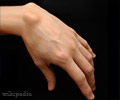ROCHESTER, Minn. – Detecting infection of prosthetic joints can now be made more precisely, thanks to a team of Mayo Clinic researchers, which has come up with a new, more accurate diagnostic test. This discovery could lead to better treatment options and patient outcomes.
The new method, which samples bacteria that adhere to the prosthetic surface, was tested in a study of 331 patients with prosthetic hip or knee joints who were having their prosthetic joints removed for infection or another cause. The new diagnostic test detected more of the infected cases (78.5 percent) than did the conventional approach (60.8 percent). The findings are published in the August 16 issue of the New England Journal of Medicine.While most people who have their hips or knees replaced experience dramatic benefit, a small percentage require additional surgery, most commonly for infection or loosening of the prosthetic joint. The conventional method for detecting infection, which has been used for decades and is still commonly performed, samples tissue around the prosthetic joint at the time of surgery.
“The problem with the conventional method is that you need multiple tissue specimens, because the sensitivity of a single specimen is not good -- in other words, the infection might be missed with just one sample,” explains Robin Patel, M.D., Mayo Clinic Professor of Medicine, who led the multidisciplinary team of orthopedic surgeons, infectious diseases physicians and laboratory researchers.
“Another issue is that bacteria normally found on the skin can be picked up on the tissue specimen as it is extracted and passes through the skin, yielding a false-positive result.
These same bacteria may actually cause the infection, so doctors can’t always tell just by the type of bacteria detected whether the patient has an infection or not. If multiple specimens are positive for the bacteria, then this indicates that the bacteria are causing the infection.”
Approximately 750,000 total hip and knee replacement surgeries are performed each year in the United States. This number is expected to increase to 2.5 million by 2030, according to a March 2006 presentation at the American Academy of Orthopedic Surgeons.
Advertisement
“When people think of infection, they may think of fever or pus coming out of a wound,” explains Dr. Patel. “However, this is not the case with prosthetic joint infection. Patients will often experience pain, but not other symptoms usually associated with infection.
Advertisement
Micro-organisms associated with prosthetic joint infection are found in biofilms, which are colonies of bacteria that adhere to the prosthesis surface. Researchers initiated the study with the hypothesis that methods that sample the prosthesis surface should improve the diagnosis of prosthetic joint infection.
The new test involves surgeons removing the prosthetic joint as they normally would, placing it in a special container, and sending it to the laboratory.
In the laboratory, a solution is added to the container and then the container is subjected to a combination of vortexing (shaking) and sonication (exposure to ultrasound) which has been shown to remove biofilm bacteria. Then, the bacteria, which are in the solution, are quantitatively cultured.
“If you look at the study, you’ll see we found a wide variety of different types of bacteria,” says Dr. Patel. “This is important to recognize, because it is ideal for the doctors to know what type of infection they are dealing with in order to treat it properly -- this determines what type of antibiotic to give, and in some cases, what type of surgery to perform.”
Source-Eurekalert
JAY/B






